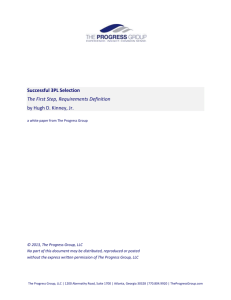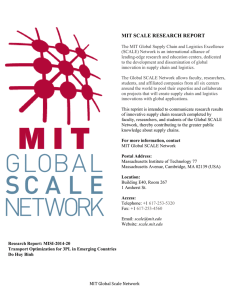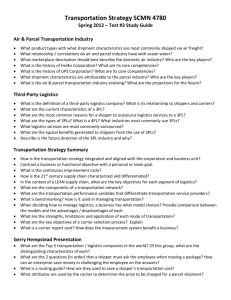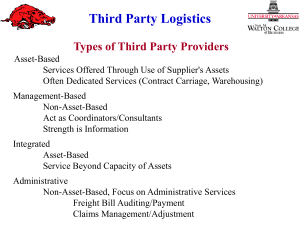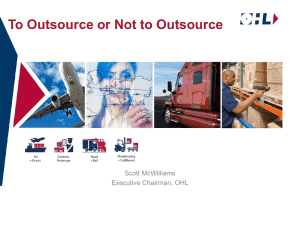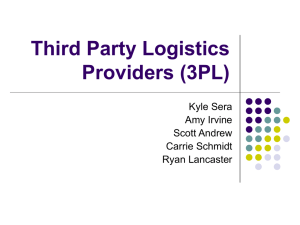MIT SCALE RESEARCH REPORT
advertisement
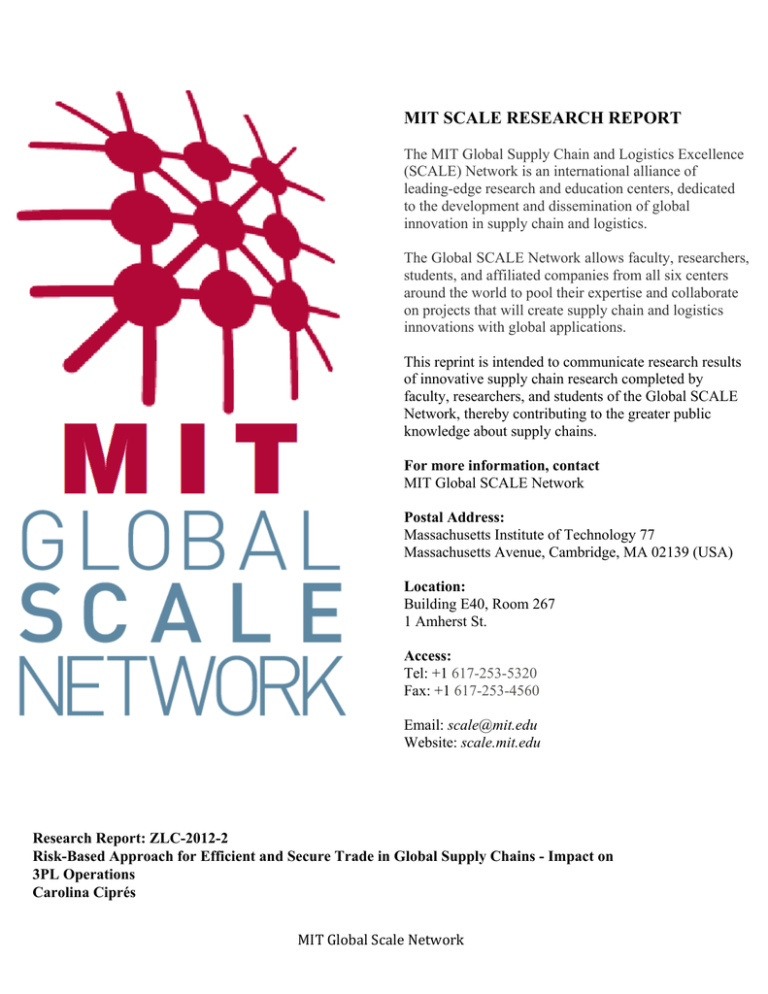
MIT SCALE RESEARCH REPORT The MIT Global Supply Chain and Logistics Excellence (SCALE) Network is an international alliance of leading-edge research and education centers, dedicated to the development and dissemination of global innovation in supply chain and logistics. The Global SCALE Network allows faculty, researchers, students, and affiliated companies from all six centers around the world to pool their expertise and collaborate on projects that will create supply chain and logistics innovations with global applications. This reprint is intended to communicate research results of innovative supply chain research completed by faculty, researchers, and students of the Global SCALE Network, thereby contributing to the greater public knowledge about supply chains. For more information, contact MIT Global SCALE Network Postal Address: Massachusetts Institute of Technology 77 Massachusetts Avenue, Cambridge, MA 02139 (USA) Location: Building E40, Room 267 1 Amherst St. Access: Tel: +1 617-253-5320 Fax: +1 617-253-4560 Email: scale@mit.edu Website: scale.mit.edu Research Report: ZLC-2012-2 Risk-Based Approach for Efficient and Secure Trade in Global Supply Chains - Impact on 3PL Operations Carolina Ciprés MITGlobalScaleNetwork For Full Thesis Version Please Contact: Marta Romero ZLOG Director Zaragoza Logistics Center (ZLC) Edificio Náyade 5, C/Bari 55 – PLAZA 50197 Zaragoza, SPAIN Email: mromero@zlc.edu.es Telephone: +34 976 077 605 MITGlobalScaleNetwork Risk-Based Approach for Efficient and Secure Trade in Global Supply Chains Impact on 3PL Operations By Carolina Ciprés Thesis Advisor: Prof. Mustafa Çagri Gürbüz Summary: This thesis considers the case of a Third Party Logistics Provider certified under a security program having both certified and non-certified customers, and analyzes the impact (in economic terms) on 3PL operations of such a problem, as well as the potential benefits that may be derived from it. Master of Engineering in Logistics and Supply Chain Management, MITZaragoza International Logistics Program, 2012 Chemical Engineer, Centro Politécnico Superior, University of Zaragoza KEY INSIGHTS 1. A 3PL having joined a security initiative is faced with the challenge of working with both certified and non-certified shippers. 2. For its operational decisions, a 3PL should take into account the penalty costs associated with these non-certified shippers, as well as the delays incurred. 3. In cases of small loads and high number of customers a 3PL should apply a cost model that includes delay costs. Introduction In recent years, supply chains have become more globalized and thus more vulnerable. Indeed, it was in the aftermath of 9/11 when governments and practitioners became more aware of how seriously supply chains could be jeopardized by security risks. To understand the impact of these security risks, one can look at security attacks such as cargo theft or counterfeiting. Cargo theft represents, in Europe, an estimated loss of 8.2 billion Euros (according to the Transported Asset Protection Association (TAPA)) (Europol, 2009). On the other hand, counterfeiting represents a major issue for specific sectors such as the pharmaceutical industry, where just in the year 2009 8.3 million doses of counterfeit products were seized (Marucheck et al, 2011). In order to tackle these security risks, governments have developed different initiatives. For instance, the U.S. Government has created the CSI (Container Security Initiative) and C-TPAT (Customs-Trade Partnership Against Terrorism). The European Commission has in turn created the AEO program (Authorized Economic Operator) under the SAFE Framework developed by the World Customs Organization. These initiatives are voluntary for businesses to join. Prior to joining, businesses should not only consider the potential security improvements but also know the collateral benefits. This thesis tackles the research question of how to achieve an efficient and secure supply chain by adopting a risk based approach to supply chain management. It looks at the case of a Third Party Logistics Provider (3PL) certified under a security program, facing the problem of having both certified and non-certified customers. The specific research questions addressed will be: What is the impact (in economic terms) on a 3PL’s operations of such a problem? How could a 3PL take advantage of the above situation and segment (shippers) to be more profitable? its customers The conclusions drawn from this analysis could be applied to the different programs mentioned above. Problem Description The increase in security awareness stated above can be especially seen in border crossings. Indeed, since 9/11, the security measures in place at the US borders have caused impacts on carriers, such as extra transit time costs (Taylor, 2004). As nowadays supply chains involve border crossings due to the increase of globalization, we consider that including border crossings into the supply chain models should help supply chain managers to better capture reality in their mathematical models. Research in the field of border crossing delays is scarce (Maltz, 2011). Nevertheless, supply chain actors joining a security program should be aware of the existing delays in order to be able to measure the benefits from joining such programs. Among the different supply chain actors, we have chosen to analyze a 3PL provider who has joined a security program. The rationale for doing so is the following: whereas a 3PL provider can be certified under a security program, it can have both certified and non-certified customers. This may lead to several problems, e.g. the 3PL not benefiting from the advantages of joining the program, the certified customers suffering delays when consolidated with non-certified shippers. The model proposed aims at 3PLs engaged in crossborder activities (as is a necessary requirement for a 3PL to join security programs such as C-TPAT). When a 3PL wants to comply with a specific security program, it has to make some investments upfront as well as incur in some maintenance costs. Therefore it has to ensure that it will be able to benefit from the advantages of joining such a program. According to Sheu (2006), transportation and freight forwarding companies incur a cost that can range from $ 3,500 to $18,000 in order to become C-TPAT certified. Rice and Spayd (2005) state that security investments can not only improve the security of the supply chain but also make it more efficient. Indeed, they point out that an operator that has invested in security can benefit from improved lead times, as the probability of having its shipment delayed decreases (through the reduction in inspections at customs). For instance, in year 2003 C-TPAT certified importers received 3 times fewer compliance citations for measurement examination than non-certified importers. Moreover, Chow (2006) concludes that FAST certified entities not only benefit from having access to designated lanes, but they may also face lower customs delays, therefore translating into lower variable costs. Nevertheless, for a 3PL operator, having noncertified customers will hinder the above benefits. If a shipment contains orders from non-certified shippers, the probability of being inspected at customs increases as well as the probability of delay. This supports the rationale for charging more to noncertified customers (as they prevent the 3PL from benefiting from C-TPAT even though they have made an initial investment). One example of the above is the business case developed by Haughton (2007) regarding the FAST program. Haughton states that in the framework of the FAST program, Canadian and US authorities have mandated that unless all of an LTL carrier’s shipments are from FAST-approved shippers, the carrier must approach the border checkpoint via a regular lane instead of a FAST lane (Canada Customs and Revenue Agency et al. 2003) resulting in an increase of lead time. Moreover, literature has shown that governments may use strategic delay to force entities to join their security programs. Indeed, Bakshi and Gans (2010) suggest that there may be cases in which customs deliberately perform inspections more frequently than required, in order to increase congestion levels and induce strategic delay. This overinspection benefits governments by providing a stronger incentive for trading firms to join security programs. According to Lee and Whang (2003), the effect of increased inspection will be: added variability because of more shipments going through inspection, added mean lead time and additional variability of lead time due to added variability of waiting time. All the above translate into more delays. Therefore, the model is built not only based on the current situation but taking into account a near future where delays may increase with these strategic delays performed by governments. Model Formulation The formulation tackles the question of how to deliver a set of K orders to a set of R regions. In the model proposed, we introduce new parameters, decision variables, and constraints, to take into account the specificities of the security problem we are looking at (i.e. the penalties incurred for late delivery due to consolidating orders from certified and non-certified shippers). The objective function is the total cost paid to transport the orders plus the penalty cost for late delivery. For the experimental design, we define two situations depending on the probability of delay due to inspection. In the first case we will consider the current probability of suffering inspection, and in the second one we will increase this probability considering that governments introduce strategic delay to enforce compliance with their programs. As it can be inferred from the model structure, the penalty costs increase with the probability of delay. The numerical analysis performed has shown some trends that may give insights for the further application of the present model. Indeed, according to the analysis results, penalty costs increase with a decrease in the order size and with the number of customers. Therefore in cases of small loads and high number of customers a 3PL should apply a cost model that includes delay costs as the one proposed in this thesis. Conclusion In the present days governments have created security initiatives that are voluntary for supply chain actors to join. A 3PL having joined such as program is faced with the challenge of working with both certified and non-certified shippers. Under such circumstances, a 3PL should take into account for its operational decisions the penalty costs associated with these non-certified shippers, as well as the delays incurred. This thesis proposes a general model to be applied by a 3PL in order to allocate different orders based on cost minimization, including penalty costs. The application of this model will show a 3PL provider the value of encouraging its customers to be certified under a security program. The numerical analysis performed in the framework of this thesis has shown some trends in the cost structure of a 3PL working with both certified and non-certified shippers, and how this model will be relevant for cases with many shippers and small loads. Nevertheless, the insights from this thesis should be validated with more quantitative results, i.e. by working with data from industry and applying this model to a specific 3PL, taking into account its own cost structure and constraints. Cited Sources Bakshi, N., Gans, N. “Securing the Containerized Supply Chain: Analysis of Government Incentives for Private Investment”, Management Science, Vol. 56, No. 2, February 2010, pp. 219-233 Chow, G. “Applying Supply Chain Logistics Modeling to Border Security and Efficiency”, Sauder School of Business, University of British Columbia, Bureau of Intelligent Transportation Systems and Freight Security (BITSAFS), August 18, 2006 Europol, “Cargo Theft Report. Applying the Brakes to Road Cargo Crime in Europe” (2009) Haughton, M. A. “Examining the business case for shipper participation in Canada–USA trade security programmes”, International Journal of Logistics Research and Applications: A Leading Journal of Supply Chain Management, (2007) 10:4, 315-331 Maltz, A. “Incorporating Land Border Crossings into Global Supply Chain Models”, Arizona State University, Council of Supply Chain Management Professionals (CSCMP), 2011 Marucheck, A., Greisb, N., Menac, C., Caid, L. “Product safety and security in the global supply chain: Issues, challenges and research opportunities”, Journal of Operations Management 29 (2011) 707–720 Rice, J., Spayd, P. “Investing in Supply Chain Security: Collateral Benefits”, IBM Center for the Business of Government, May 2005 Sheu, C., Lee, L., Niehoff, B. “A voluntary logistics security program and international supply chain partnership”, Supply Chain Management: An International Journal 11/4 (2006) 363-374 Taylor, J., Robideaux, D., Jackson, G. “U.S.-Canada Transportation and Logistics: Border Impacts and Costs, Causes, and Possible Solutions” Transportation Journal; Fall 2004; 43, 4



